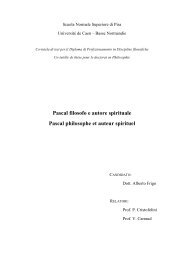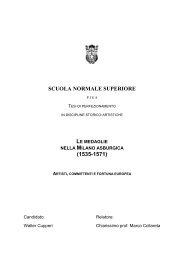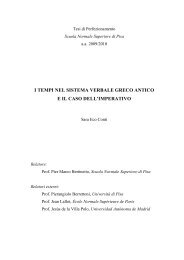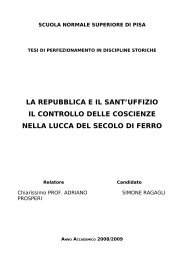CATULLUS 68 - Scuola Normale Superiore
CATULLUS 68 - Scuola Normale Superiore
CATULLUS 68 - Scuola Normale Superiore
You also want an ePaper? Increase the reach of your titles
YUMPU automatically turns print PDFs into web optimized ePapers that Google loves.
even printed by Lachmann and later editors, but many others have been ignored. There is no reason to revive<br />
most of these. In short, even in an edition on this scale it is inevitable to be selective when quoting<br />
conjectures. Still my apparatus is probably more full than that of any other edition of this text. The<br />
inconvenience caused by its bulk is hopefully counterbalanced by the value of the information that it<br />
contains.<br />
Orthography One problematic aspect of the constitution of the text involves choices regarding spelling.<br />
Current editions of Catullus generally follow the spelling conventions of the later Roman Empire. The<br />
evidence of inscriptions and nuggets of information conserved by later writers show that earlier authors used<br />
a different orthography, or rather orthographies: conventions not only changed over time, but they were<br />
flexible to the point that one can sometimes find different forms of the same word within the same text. This<br />
makes it very difficult to infer what orthography Catullus would have used. The problem has been studied by<br />
Cremona in an important article that has not received the attention that it deserves. 177 The forms that he<br />
studies fall into two groups. In the case of the first group we know that only one form was used in the late<br />
Republic, but it became obsolete only later. Here Catullus must have evidently used the earlier forms, such<br />
as initial uo- rather than uu- (uolturius), quoi rather than cui, quom rather than the conjunction cum, and<br />
double intervocalic s (caussa, diuissio, cāssus). 178 The second group comprises alternative forms which<br />
existed alongside each other in the mid-1 st century B.C., sometimes even within one and the same text. In<br />
these cases Cremona tries to determine with the help of the MSS which form Catullus will have used. He<br />
suggests that in line 82 of poem <strong>68</strong> we should write hiemps rather than hiems, since O writes hyemps, while<br />
G and R have hyems. 179 It is certainly probable that the archetype should have read hyemps – O was in the<br />
rule more conservative than X – but it is in any case impossible to tell whether the p was inserted by Catullus<br />
himself or by a later copyist (see ad loc.). Still more problematic is the choice between ei and i. In an earlier<br />
period the spelling ei was reserved for genuine diphtongs such as deico and bonei nom. pl., but by this time<br />
ei had already merged with ī in the spoken language, and ei and i were often used indiscriminately in writing.<br />
Cremona infers from the evidence of the MSS that in rare cases Catullus wrote ei, using the archaic spelling<br />
generally in order to give a touch of antiquarianism to what he wrote, as when a modern English pub is<br />
called ‘The Olde Taverne’. 180 But I find it hard to believe that Catullus with his racy style should have<br />
followed such a strategy. In general, there is very little reason to trust the manuscripts in questions of<br />
spelling: the archetype A was already extremely corrupt, and it contained medieval forms such as the dative<br />
michi, so it is not certain and not even probable that its orthographical archaisms should go back to Catullus.<br />
177<br />
Cremona 1958.<br />
178<br />
Cremona 1958: 408f., 410f. and 425f. On double intervocalic s see on line 67 clausum.<br />
179<br />
Cremona 1958: 426f.<br />
180<br />
Cremona 1958: 414-418.<br />
80






